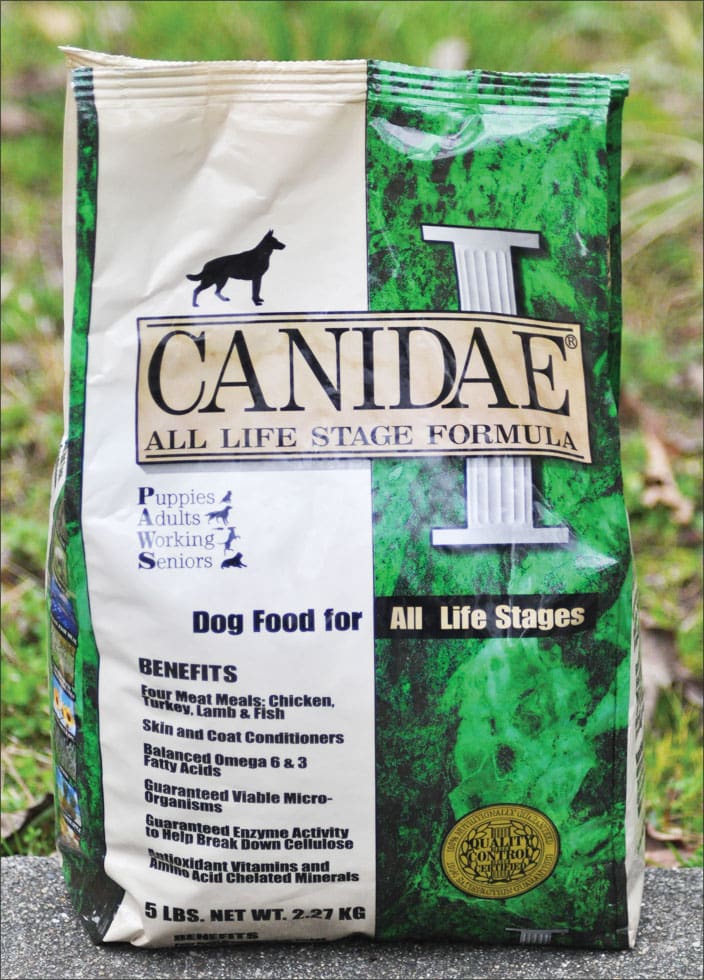Identifying a top quality dog food is not that difficult; I’m going to tell you how to do it in just a minute. But it may be difficult to find dog foods of this quality if you live far from an urban center or an independent pet supply store run by someone with more than a passing interest in canine nutrition. It may be even more difficult to afford some of the dog food brands listed; quality pet food ingredients cost more. But it shouldn’t be at all hard to see the improvements in your dog’s health if you’ve been feeding a low-quality food and make the switch to products of this quality.
Tip # 1: Whenever possible, shop at well-trafficked independent pet supply stores. The staff and/or management is usually far more helpful and knowledgeable about products that would be best for your dog at your budget. Next best: chain pet specialty stores.

288
If you wear glasses to read fine print, bring ’em! You are going to study the label of each product in your price range for the following:
– Ingredients panel (where the ingredients are listed in descending order of weight in the product). More about this in a minute.
– Guaranteed analysis (which lists the minimum amounts of protein and fat and the maximum amounts of fiber and moisture, and sometimes, other nutrients). You need to know how much protein and fat your dog’s food at home contains, and whether he should get more or less. If you’ve been feeding a low-quality food with, say, 19% protein and 8% fat, you don’t want to switch overnight to a sled-dog fuel with 40% protein and 28% fat.
– “Best by” date/code (and sometimes, the date of production, too – it’s ideal to have both listed). Look for the freshest food possible, with the “best by” date at least 6 months away.
– AAFCO statement (which tells you whether the food has met the requirements of a “complete and balanced” diet, and if so, by which standard: by meeting the required nutrient levels, or by completing an AAFCO feeding trial). For more information about the difference, see “Whole Dog Journal’s 2007 Dry Dog Food Review,” WDJ February 2007.
Hallmarks of Quality
Now it’s time to scrutinize the ingredients list. The following are desired traits – things you want to see on the label.
– Lots of animal protein at the top of the ingredients list. Ingredients are listed by weight, so you want to see a lot of top quality animal protein at the top of the list; the first ingredient should be a “named” animal protein source (see next bullet).
– A named animal protein – chicken, beef, lamb, and so on. “Meat” is an example of a low-quality protein source of dubious origin. Animal protein “meals” should also be from named species (look for “chicken meal” but avoid “meat meal” or “poultry meal”). I go into greater detail about this in “The Dog Food Industry Has Come a Long Way!, WDJ February 2013.
– When a fresh meat is first on the ingredient list, there should be an animal protein meal in a supporting role to augment the total animal protein in the diet. Fresh (or frozen) meat contains a lot of water, and water is heavy, so if a fresh meat is first on the list, another source of animal protein should be listed in the top three or so ingredients.
– Whole vegetables, fruits, and grains. Fresh, unprocessed food ingredients contain nutrients in all their natural, complex glory, with their fragile vitamins, enzymes, and antioxidants intact. Don’t be alarmed by one or two food “fractions” (a by-product or part of an ingredient, like tomato pomace or rice bran), especially if they are low on the ingredients list. But it’s less than ideal if there are several fractions present in the food, and/or they appear high on the ingredients list.
– A “best by” date that’s at least six months away. A best by date that’s 10 or 11 months away is ideal; it means the food was made very recently. Note: Foods made with synthetic preservatives (BHA, BHT, ethoxyquin) may have a “best by” date that is as much as two years past the date of manufacture.
Avoid These Traits
The following are things you don’t want to see in the ingredients.
– Meat by-products or poultry by-products. Higher-value ingredients are processed and stored more carefully (kept clean and cold) than lower-cost ingredients (such as by-products) by meat processors.
– A “generic” fat source such as “animal fat.” This can literally be any fat of animal origin, including used restaurant grease. “Poultry” fat is not quite as suspect as “animal fat,” but “chicken fat” or “duck fat” is better (and traceable).
– Added sweeteners. Dogs, like humans, enjoy the taste of sweet foods. Sweeteners effectively persuade many dogs to eat foods comprised mainly of grain fragments (and containing little healthy animal protein).
– Artificial colors, flavors, or preservatives (i.e., BHA, BHT, ethoxyquin). The color of the food doesn’t matter to your dog. And it should be flavored well enough to be enticing with healthy meats and fats. Natural preservatives, such as tocopherols (vitamin E), vitamin C, and rosemary extract, can be used instead. Note that natural preservatives do not preserve foods as long as artificial preservatives, so owners should always check the “best by” date on the label and look for relatively fresh products.
Good examples: WDJ’s “Approved Dry Foods”
We’ve used the criteria above to assess the product lines of the following companies, representing hundreds of different dry dog foods. All of the products listed below meet our basic selection criteria for top-quality foods.
We’ve listed the first six ingredients and the minimum percentages of protein and fat from a representative product from each company.
Please note that the products are NOT rated or ranked; they are listed alphabetically by COMPANY. So, for example, if you are looking for Origen, look under its maker, Champion Pet Foods.
Adjust As Necessary
You may have been told that it’s bad to switch foods, or you may have had a bad experience when your dog ate something different and erupted in gas or diarrhea. With most dogs, the more you change foods, the more robust and capable their digestion becomes. We suggest switching foods every few months (or even more frequently; we switch our dogs’ food with every bag). Switching foods frequently also helps prevent the development of allergies, and helps provide nutritional “balance over time.” If your dog ate the same food for months and years, the nutrient levels – particularly the mineral levels – become literally entrenched in your dog’s body. This can be particularly harmful if the food you feed contains excessive or insufficient levels of certain vitamins or minerals.
Finally, watch your dog! Let her tell you how the new food works for her. Keep track of what foods you’ve tried (when the bag is empty, we cut out the ingredients panel and tape it to the calendar). This way, you can continue to make adjustments and improvements in your dog’s diet – and, we hope, huge improvements in her physical condition, skin and coat, and overall energy level.
For a more in-depth look at the (improving) changes in the pet food industry, check out “The Dog Food Industry Has Come a Long Way!, WDJ February 2013.





